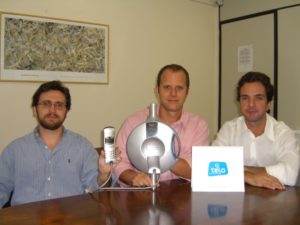TÉLO is the first public telephone especially designed for public transport vehicles. Using a card for payment, millions of people using public transport are already
using the phone on buses, trains and underground transport networks.
Founded in August 2004, by Paulo Lerner and André Averbug, Brazilian company PV Inova (Public Vehicular Innovations) invented the system and have registered a patent to protect their intellectual property, initially
in Brazil.

In choosing further countries for patent registration, PV Inova will be targeting other countries with similar social profiles as Brazil, in Latin America, East Asia and Africa. In these countries, millions of people use public transport and rely on public communication networks rather than personal mobile phones. They will also register the patent in Europe and the USA for strategic purposes – to deter competition for as long as possible.
PV Inova has a social mission – to make communication accessible and affordable to the masses. They also have commercial objectives and recognise that these customers, though not wealthy as individuals, collectively have massive amounts of money to spend. The company has used socio-economic statistics combined with transportation data to analyse the Brazilian market. Instead of focusing on the wealthy elite, their income streams will come from the aggregated spending power of millions of ordinary people. This is a ‘base of the pyramid’ or ‘BoP’ strategy, selling services in high volume but at low prices.
Innovate in product design, Leonardo and his colleagues at PV Inova have used a novel combination of strategies to raise funds for their projects. Investors see the potential of the company and PV Inova has had two rounds of investment, firstly from a ‘business angel’, and later from an ‘investment club’ of seven smaller shareholders. 80% of shares are owned by the three executive partners, with the remaining 20% shared by 11 others. The company’s business plan forecasts an outstanding return on investment. PV Inova also plans to reinvest its profits in further technological developments, including digital TV.
Apart from the huge Brazilian public transportation market, growth will also come from international strategic partnerships with telecommunications companies, based on the provision of the service and the licensing of their intellectual property.
Download this post as an article. (PDF, 115KB)
Download article
Link to PV Inova website.
Please contact me with other examples of creative enterprises using interesting marketing strategies and intellectual property to develop their businesses.